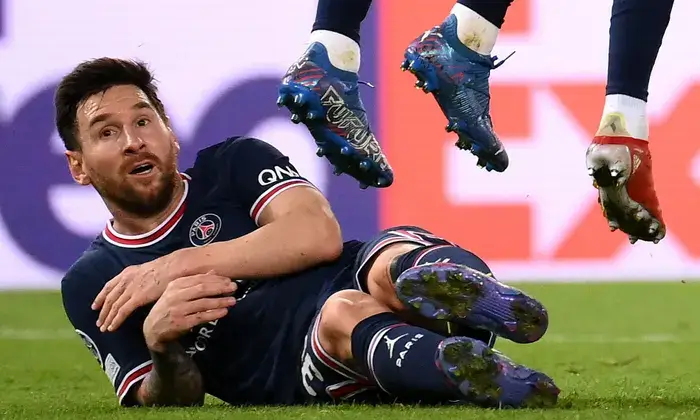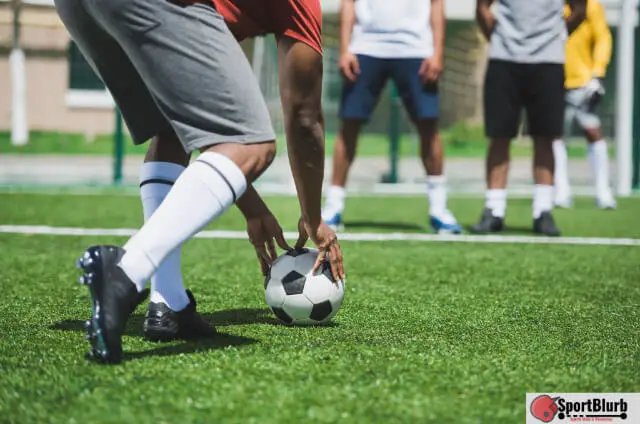Last Updated on October 25, 2023 by Alex PT
Yes, pro soccer players do wear metal cleats. Metal cleats provide superior traction on wet and muddy pitches, which is important for professional players who need to be able to make quick cuts and changes of direction. Metal cleats are also more durable than rubber cleats, which can be important for players who play multiple games per week.
The Table Below Contains Some Popular Cleats With Metal Spikes.

| Top Metal Cleats | Examples of players that use them |
| Puma evoPOWER 1.3 | About 1.6 percent of players wear the Puma evoPOWER 1.3 boots, which makes it crack up to the top 10. These cleats are specifically designed for midfielders and they are made from synthetic material. Popular Players: Olivier Giroud, Mario Balotelli, Gianluigi Buffon, Yaya Toure, and the likes |
| Puma evoSPEED SL II | This is another top-notch cleat from Puma, which is used by 2.1 percent of players. These cleats are used by top players around the world. It is an ideal cleat for attackers since it’s built for top speed. Popular players: Marco Reus, Antione Griezman, Romelu Lukaku, Frank Ribery, Sergio Aguero, and the likes. |
| Nike Hypervenom Phantom II | Nike’s Hypervenom Phantom II boots are designed with the company’s Flyknit technology. About 3.1 percent of players wear these cleats since they boast of a high collar that extends from the mouth of the shoe. Popular players: Robert Lewandowski, Riyad Mahrez, Pierre-Emerick Aubameyang, Daniel Sturridge, and the likes. |
Do Pro Soccer Players Wear Metal Cleats
- The Use of Metal Cleats: The truth is, some professional soccer players do wear cleats with metal studs, but this isn’t the thrift of the pack. Metal studs, sometimes known as metal spikes, offer a great grip on fields that are particularly slick or wet.
- Understanding the Rules: FIFA’s equipment regulation allows all types of studs, including metal, as long as they are not dangerous, which generally means they must be well-constructed and round.
- Concern of Player Safety: However, a common concern with metal cleats lies in player safety. Due to their excellent grip, there is a risk of injury when the metal stud gets caught in the turf.
- Material of Choice: Many pro soccer players choose synthetic studs over metal for a variety of reasons, primarily concerning player comfort and safety.
- Conditions Dictate the Choice: That being said, the choice of studs, whether metal, plastic, or rubber is largely dependent on pitch conditions on the day of the game.
- The Changeable Cleat: Some modern soccer boots feature changeable cleats. These models allow players to swap out plastic or synthetic studs for metal ones when conditions require it.
- Cleat Length Variety: It’s not so much the material, but the length of the stud that often varies according to field conditions. Longer studs, sometimes even metal, can be used in rainy weather for better field penetration and grip.
- Hard Ground vs Soft Ground Cleats: Cleats with metal studs are typically referred to as soft ground (SG) cleats. They are worn on wet and sloppy fields. On the other hand, hard ground (HG) or firm ground (FG) cleats, which usually have plastic studs, are used on hard, dry fields.
| Basis | Metal Studs | Synthetic Studs |
|---|---|---|
| Use in Professional Soccer | Yes, conditional | Yes, common |
| Player safety | Potential risk | Generally safer |
| Field condition | Wet/sloppy fields | Hard/dry fields |
| Cleat type | Soft Ground (SG) Cleats | Firm Ground (FG) or Hard Ground (HG) Cleats |
Heavy Metal
We have seen players in sports like rugby, baseball, soccer, golf, and football use cleats with metal spikes for decades. Metal spikes usually come in different shapes depending on the sport you play. Also, they are arranged in different patterns and come in different lengths. For durability and strength, the spikes on these cleats are made with steel. Since there is a possibility that one of the metal spikes might wear out, bend, or break off before the shoes, mid- and high-range cleats are designed with replaceable spikes. If the spikes wear off before the cleats themselves, you don’t need to replace the entire pair of cleats.
Check League Rules
Due to some injury concerns, most of the youth soccer leagues ban the use of cleats with metal spikes. Even outside soccer, other sports also do not encourage the use of cleats with metal spikes. Like in Little League Baseball America, young players in the divisions of 9 to 10 years old and younger are not allowed to wear cleats with metal spikes, they are only allowed to wear plastic cleats. Many other leagues that regulates youth sports such as the NFL, and the Rugby League, also disallow the use of metal spikes, making the use of plastic spike essential for all young players. The use of cleats with metal spikes has also been prohibited by some adult recreation leagues for flag football and softball. Only professional soccer players are permitted to wear metal cleats since they’ve been well-trained in how to use these cleats without having to injure their teammates or opponents.
In soccer, players make use of their feet to control the ball more than any other part of their body. So, it’s ideal to say that the cleats they wear are one of the most important pieces of equipment in their trade. We’ve compiled a list of the top three pro soccer cleats with metal spikes.
1. Puma evoPOWER 1.3
About 1.6 percent of players wear the Puma evoPOWER 1.3 boots, which makes it crack up to the top 10. These cleats are specifically designed for midfielders and they are made from synthetic material. Popular Players: Olivier Giroud, Mario Balotelli, Gianluigi Buffon, Yaya Toure, and the likes.
2. Puma evoSPEED SL II
This is another top-notch cleat from Puma, which is used by 2.1 percent of players. These cleats are used by top players around the world. It is an ideal cleat for attackers since it’s built for top speed. Popular players: Marco Reus, Antione Griezman, Romelu Lukaku, Frank Ribery, Sergio Aguero, and the likes.
3. Nike Hypervenom Phantom II
Nike’s Hypervenom Phantom II boots are designed with the company’s Flyknit technology. About 3.1 percent of players wear these cleats since they boast of a high collar that extends from the mouth of the shoe. Popular players: Robert Lewandowski, Riyad Mahrez, Pierre-Emerick Aubameyang, Daniel Sturridge, and the likes.
Final Words
The bottom line is that most pro soccer players use metal cleats since all of the fields they play on are grasses. Nevertheless, metal cleats aren’t allowed to be utilized in youth leagues therefore the kids wouldn’t injure themselves. Metal cleats can lead to great injuries for players if not correctly utilized by professionals. Much more reasons it’s forbidden in youth leagues. Stability is among the catalysts for the greatest sports performance no matter what sports you play. As an athlete, before you can drive off for one run, twist, throw, turn, kick, or catch, your feet have to get well placed beneath you. We’ve come to the final chapter of this informative blog post. We hope you were able to find resources in your quest to know whether pro soccer players wear metal cleats. Please do not hesitate to contact us for questions or comments. Thanks!
References:
https://professionalshq.com/do-professional-soccer-players-wear-metal-cleats/
https://www.quora.com/Do-soccer-players-wear-metal-cleats

Hi! I’m Alex PT. I hold a Bachelor’s degree in Sports Management from Indiana University and have over seven years of valuable experience working in a Sports Event Management Company. I founded SportBlurb with the passion for bringing you the latest, most insightful, and engaging content in the world of sports. So, whether you’re a die-hard fan or want to stay informed, I’ve got you covered!

